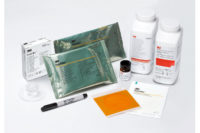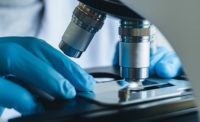Food safety: The case for environmental pathogen sampling
Controlling environmental pathogen sources is a key component of food safety systems in dairy processing plants.


|
| The Food and Drug Administration has a long history of inspecting milk. In 1914, John Earnshaw (in hat) inspected a milk wagon in the Washington, D.C. and Baltimore area |
With a few exceptions (for example, raw milk cheeses), dairy processing includes a highly effective kill step that effectively controls pathogens that may be present in the raw material, and specifically raw milk.
The presence of pathogens in dairy products for which processing includes a pasteurization step can thus be traced back to a few scenarios, including:
- Presence of extremely high pathogen loads in raw milk, which may allow for presence of a few surviving organisms after pasteurization;
- Introduction of pathogens through ingredients added post-pasteurization;
- Post-pasteurization re-contamination of products from environmental sources.
Scenario 1 is extremely unlikely in countries where raw milk quality is high and where the potential for pathogen growth (failure to refrigerate raw milk, for example) has been limited due to appropriate regulations and food safety systems.
Introduction of pathogens through ingredients, on the other hand, represents a considerable concern. For example, a number of foodborne disease outbreaks (not necessarily in dairy products) have been linked to spices contaminated with Salmonella. This scenario not only represents a risk when spices are added to a product after pasteurization, but also can represent a risk even if processing includes a heat treatment step after the addition of ingredients, as Salmonellapresent in dry ingredients and low-water activity environments shows a significantly increased heat resistance over Salmonellapresent in high-water activity environments, such as milk.
Post-pasteurization contamination of dairy products represents the biggest concern for all sizes of dairy processors. Consequently, strategies to control post-pasteurization contamination are critical components of any food safety plan in the dairy industry. While post-pasteurization contamination can occur with virtually any pathogen, key organisms of concern include the bacteria Salmonella, Listeria monocytogenes andCronobacter species(formerly known as Enterobactersakazakii). The latter organisms are predominantly a concern in plants that manufacture powdered infant formula.
While all three of these organisms can survive for extended periods outside human and animal hosts, the documented ability of Salmonellaand Listeria monocytogenesto survive in food processing plants for extremely long times (around at least 10 years) represents a particular concern and challenge.
The issue of environmental pathogen persistence has become even more important as U.S. food safety agencies are now routinely using DNA fingerprinting tools to characterize pathogen isolates obtained from foods or processing plants as part of testing performed by state or federal agencies. In some cases, identification of the same pathogen fingerprint in food and/or environmental samples collected at different time points (that may be weeks, months or even years apart) may be interpreted as an indication of persistence of this given pathogen in a processing facility. This can, in some cases, be a cause for a bracketed recall that does not just affect a single lot number that was found to be contaminated, but may affect all lots that have been produced in a given plant during the presumed time of pathogen persistence.
Short of complete closed processing systems (including aseptic filling systems) that eliminate opportunities for any post-pasteurization contamination, prevention of post-pasteurization contamination typically requires a multipronged approach that includes good manufacturing practices (GMPs), sanitation standard operating procedures (SSOPs), sanitary equipment and plant design, and last but not least, appropriate environmental testing programs for the organisms of concern.
Even though the Food Safety Modernization Act documents released to date do not include a requirement for environmental pathogen sampling, there is broad consensus that environmental pathogen testing is a critical component of any food safety plan, including in the dairy industry. Development and implementation of an appropriate environmental plan nevertheless continues to often be a challenge because there is no one size-fits-all protocol or approach.
Key consideration and decisions in the development of sampling plans include:
- What are the target organisms? (e.g., Salmonella; Listeria monocytogenes)
- What do we test for? (the target pathogen or an “indicator,” e.g., Listeriaspp.)
- When do we test? (after sanitation? before start-up? during production?)
- Where do we test? (food contact surfaces? drains? distribution of samples by zones?)
- How often do we test?
Giving general guidance for all of these questions is challenging as the decisions depend on a variety of factors, including the type of plant and the type of product produced, previous sampling data and customer requirements, to name only a few. Similar to HACCP plans, any given plant needs to design its own plan for its specific circumstances.
Importantly, while environmental sampling in dairy plants has the overarching goal of preventing post-pasteurization contamination, the specific goal of sampling may differ by facility, sampling site and sampling time. Some samples may be taken to specifically validate sanitation procedures, while other samples may be taken predominantly to identify niches where a target pathogen can persist over time.
A critical component of each environmental pathogen sampling plan is the development of a written plan and SOP (standard operating practice) that defines the action that will be taken if a given sample tests positive for the target organism. It is not unheard of that facilities initiate sampling without clear written plans for follow-up actions on positive findings, including plans for documenting the follow-up actions taken after a positive sample.
Having environmental sampling plans without clearly documented plans for follow up represents an unnecessary risk for any operation. In addition, formal procedures should be in place to summarize sampling data over time and to analyze long-term trends; for example, a quarterly formal and documented review of environmental sampling data.
Designing and implementing good environmental testing plans is not trivial and requires either in-house or external expertise. If you are involved in any aspect of dairy manufacturing, then this article hopefully will inspire you to review the environmental sampling plan in place with particular focus on the appropriate design of the sampling plan, including its potential to detect persistent pathogen contamination; written plans for actions that will be taken after a positive sample; and a schedule for regular formal review of environmental sampling data. n
Martin Wiedmann, DVM, PhD; Matthew Stasiewicz, MS; and Robert Ralyea, MS, RS; work in Cornell University's Department of Food Science, College of Agriculture.
 Automated systems have a role in food safety
Automated systems have a role in food safety
While production plant workers are on the front lines of food safety, the IT department plays a key role, too. For example, automating record-keeping enables better data collection. Dairy Foodsasked Katie Beissel, Global Industry Manager, Food & Beverage, for GE Intelligent Platforms, how automated systems can aid dairy processors in food safety.
Dairy Foods:What’s wrong with manual recordkeeping?
Beissel:Two distinct advantages of electronic recordkeeping are minimizing human error and capturing digital signatures. By digitizing track-and-trace requirements, manufacturers have quick and easy access to production information that can turn even the worst food safety issue into manageable occurrence. This can help quickly identify which raw material, piece of equipment, or production lots were involved, allowing manufacturers to quickly understand the impact on their products and supply chain.
Dairy Foods: What does an automated system offer a dairy processor?
Beissel:Automation will enable better data collection. This will also aid dairy processors in avoiding missing data, like when an operator forgets to fill out a paper form. By utilizing an electronic record-keeping process, digital signatures can ensure accountability.
Furthermore, the ability to manage product specs and to use those specs to trigger proactive work instructions enables operators to act as fast as possible. Dairy processors can take advantage of the most advanced real-time alarming and trending notifications on the market so they can take the right corrective actions to minimize risk and cost. Digitizing these processes helps eliminate data holes, putting the dairy processor in greater control of its food safety program.
Dairy Foods:How easy is it to integrate an automated reporting system into an existing system?
Beissel:In understanding the need for flexibility, some automated reporting systems leverage an open and layered technology approach to help protect existing and future investments, including integration with third-party products.
In addition, the utilization of service-oriented architectures to share data across multiple Operations Management platforms, including LIMS, MES, ERP and HMI/SCADA, is the ideal approach. By adopting a shop-floor-to-top-floor approach to food safety, quality and overall operational excellence, this methodology enables dairy processors to support their business processes across organizational and systematic boundaries and is critical to drive supply chain excellence.
Dairy Foods:Some processors run mock recalls. How can an automated system help with this?
Beissel: By having automation and software tools in place, running a mock recall could be as simple as pulling up a single genealogy or track-and-trace report for a particular finished-product lot code, ingredient lot or packaging lot. The dairy processor can quickly track a raw material on the production line and follow that material through process genealogy down all the way through the sub-lots of finished products.
Dairy Foods:What other reports can a processor run from an automated system? How else can the data that is collected be analyzed?
Beissel:Dairy processors can improve equipment efficiencies, minimize disruptions and reduce waste in their production processes without sacrificing food quality and safety. The root of many food-safety issues is a result of a process deviation, operator error or equipment breakdown. Increasing production and equipment reliability through automation minimizes these process interruptions, thereby improving quality through right first time manufacturing and reinforcing food safety.
The very same data captured and reported for enabling quality improvements and proving food safety is linked to efficiency data. In addition, dairy processors can gain insight into their processes by automating real-time data collection for visualization. By enabling operators to make decisions based on this improved data visibility, this empowers them to address small issues before they escalate into bigger problems.
Martin Wiedmann, DVM, PhD; Matthew Stasiewicz, MS; and Robert Ralyea, MS, RS; work in Cornell University's Department of Food Science, College of Agriculture.
Looking for a reprint of this article?
From high-res PDFs to custom plaques, order your copy today!






